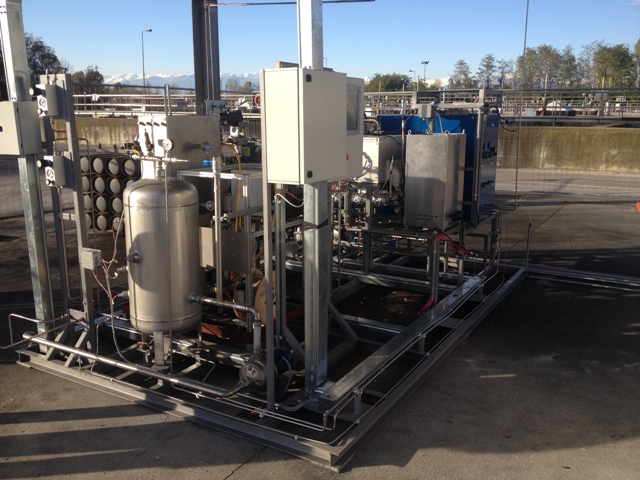Mar 30 2015
The EU project SOFCOM is coordinated by Politecnico di Torino. The project developed a break-through solution to transform the organic waste collected in wastewater treatment plants into valuable energy products through the use of high-efficiency fuel cell technology.

Matching environmental sustainability to energy efficiency through poly-generation: this is the focus of SOFCOM, a project financed by the EU Commission through a dedicated technological platform that goes under the name of the Fuel Cell and Hydrogen Joint Undertaking (FCH-JU), an initiative under the VII Framework Programme.
The project coordinator is Politecnico di Torino along with other 10 partners spread across 7 countries both from the academy and the industry[1]. The rationale behind the project (with an overall budget of 6.2 million euro) is to make energy efficient wastewater treatment plants (WWTPs) where biologically active wastewater from urban and industrial users is converted to clean water and energy. A novel process has been designed, built and tested to produce electricity and heat from the biogas generated from the sludge that is fed to anaerobic digesters within the WWTP. Along with combined electricity and heat production (CHP), two additional products are generated: filtered water and clean CO2 that is recycled to grow algae so that the carbon that is originally contained in biogas is made available again as a fuel.
The prototype plant that demonstrates the feasibility of the SOFCOM concept has been presented today during the conference “Patrimonio idrico, risorse rinnovabili e ambiente. Il presente e il futuro della depurazione in Europa”, an event held in Torino and organized by SMAT Spa, which is partner of SOFCOM.
The prototype plant – Massimo Santarelli explains, Professor at the Department of Energy of Politecnico di Torino and project coordinator – “foresees an integrated poly-generating energy system that uses renewable fuels (digester gas from WWPT and bio-syngas from wood gasification) in high-efficiency fuel cell electrochemical generators that allows for the complete recovery and re-use of CO2 so to close the carbon cycle of the plant”.
The term SOFC (Solid Oxide Fuel Cell) refers to the specific fuel cell technology exploited in the project. SOFC generators operate at around 800 °C and are in fact the most efficient fuel cell devices that can be directly fed with methane fuel, syngas or biogas (as in the case of SOFCOM).
The core component of the SOFCOM plant is the fuel cell stack reactor where biogas is transformed to electricity through efficient electrochemical reactions instead of combustion reactions that take place in less efficient internal combustion engines (ICEs). The overall fuel cell electrical efficiency is >50% when running on biogas and the only exhausts of the plant are pure CO2 and water. Compared to ICEs, the efficiency is 10-20 percentage points higher and with virtually zero emissions.
From an energy strategy point of view, the demo plant aims at demonstrating how Smart Fuel Cell based systems are key-enabling technologies that run on renewable fuels with best-in-class electric conversion efficiency and the potential for a closed-loop cycle on C-H-O atoms (carbon, hydrogen and oxygen). Such paradigm is that of new poly-generating systems for co-production of electricity, heat, fuels and chemicals.
In a conventional gas engine, the exhaust gas is heavily diluted in nitrogen so that is both energy and economic intensive to capture CO2 for subsequent sequestration or re-use. In the SOFC, the fuel exhaust is instead N2-free so that is relatively easy to capture pure CO2 for further use. This is right what happens inside the SOFCOM plant.
The SOFCOM plant is now installed in one of the largest EU wastewater treatment plant that is located nearby Torino (ITALY) . The fuel cell plant with carbon capture is followed by a photobioreactor (PBR) plant where water still rich in micro-nutrients (phosphates and nitrates) is purified by growing micro-algae. The carbon source for algae comes from the SOFC plant that makes available pure dry CO2 to the PBR.
Started in 2011, the SOFCOM project in now approaching its conclusion. Levering from the promising results achieved during the project, Politecnico di Torino has been awarded a new FCH-JU project called DEMOSOFC. The project foresees the installation of a 175 kWe SOFC plant that will run on sewage biogas. SMAT is also partner of the project and will host the installation. The plant will be largest EU SOFC plant running on biogas. At the moment, the SOFC technology has manufacturers in Germany, UK, Italy , USA and Japan. WWTPs are among the most interested end-users of the SOFC technology as electricity is consumed on-site and biogas fuel is locally produced. Investment costs are still quite high for the technology, but competitive costs are reachable as new installations are issued. Compared to ICEs, SOFC promise higher revenues due to the higher electrical conversion and lower maintenance costs.